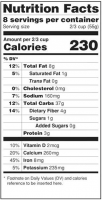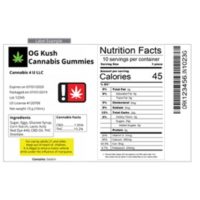38 states with legalized cannabis. 38 versions of cannabis laws. All with the same objective – to ensure consumer product safety. Commonly, state laws point to federal standards that exist for child resistance (Poison Prevention Packaging Act (PPPA)), pesticides (Federal Insecticide, Fungicide, and Rodenticide Act (FIFRA)) and food handling (Food Safety Modernization Act (FSMA)).
That said, between the 38 states, there’s plenty of differences and those show up in the nitty-gritty details that appear on the product label – health warnings, regulatory statements, THC symbols, THC limits and more.

This fragmented regulatory environment creates confusion, cost and risk. It also challenges brand owners and licensees to be thorough in their discussions around costs and responsibilities. Planning for packaging & labeling in advance will help maintain brand integrity, control costs, and ensure compliance across states. Here are some of the nitty-gritty details to consider:
Brand Design/Logo
Building a successful brand starts with giving it a name and designing a distinctive look that speaks to your target market. Are you selling in one state or do you plan to expand? Commonly, state regulations prohibit images of humans, cartoons and children as well as any resemblance to commercially available non-cannabis consumer food, beverage or candy products. But what about images of fruit? Be careful. Be prepared to adapt. In Massachusetts and Illinois, images of apples, lemons and berries on the package are fine, but in Maine and Maryland they’re not. Some states regulate colors and layout.
Font Specifications
Within labeling regulations, some states specify easy-to-read fonts (e.g., Arial, Helvetica, Times Roman), font style (e.g., bold, all capitals), and font size (e.g., 1/16” is the minimum in some, 1/12” in others). Illinois relies on reasonable judgment – “Warning statements should be of a size that is legible and readily visible to a consumer inspecting a package.” If you may have any questions on legibility, think about what an inspector may say.
Warnings & Regulatory Statements

Warnings printed on cannabis labels differ from state-to-state but all contain verbatim statements regarding health risks, pregnancy, breastfeeding and emergency instructions. Most advise caution though some say “impairment” while others say “intoxicating” and “illegal.”
Regulatory statements, like warnings, are usually provided verbatim. The statements can be age requirements, health authority disclaimers or testing disclaimers. Always required is the manufacturer name, contact information and a version of “keep away” from children and animals.
Edible Requirements
Edible labels are regulated the same as consumer packaged foods so must include ingredients, allergens, nutritional values, but some states require more or different information. For example, depending on the state, consumers are warned that edible “effects may be delayed.” In Massachusetts, Illinois, New Jersey and Maryland, the label specifies the delay could be “2 or more hours.” In Maine, New York, the warning says “4 hours or more.” Other states simply warn without a quantitative measure, or fail to mention it.
THC Symbol
One of the more obvious examples of differing labeling requirements between states is the THC symbol. Starting with CA and CO, each state that legalized cannabis chose to design and adopt a unique THC symbol (with the exception of ME, VT and MA, which share one). In 2020, Doctors for Cannabis Regulation proposed a universal THC symbol, the “International Intoxicating Cannabis Product Symbol (IICPS)”. In 2022, ASTM International recognized the symbol and published the Standard Specification for International Symbol for Identifying Consumer Products Containing Intoxicating Cannabinoids and it’s starting to take hold in the U.S.
Batch Specific Information
This is the label that is printed on site and applied to a finished package. Again, requirements may differ between states but typically, at a minimum, this label will include a batch number, product identifier, manufacture date, weight, package date, test date and cannabinoid potency values, and more.
A growing segment of consumers are becoming more educated and seeking to make informed decisions about the cannabis products they are inhaling, ingesting or applying. Beyond THC and CBD potency, they want to know about other cannabinoids, terpenes and flavonoids. For them, QR codes that link to this information are highly valued. Is this part of your brand strategy?
When designing the package for any one state, it’s important to create a template batch label and specify on the label artwork where it will be applied. This way, you will avoid stickers covering your beautiful branding or worse, obscuring regulatory content.
And Finally, The Container
 Cannabis packaging suppliers offer a wide range of containers designed to meet federal child resistance regulations. (Request certification documentation for your records.) Other considerations are the brand strategy. What’s the “look and feel”? Simple for the budget-conscious, premium for the luxury buyer? Will you be offering single servings, multiple servings, how many flavors/strains?
Cannabis packaging suppliers offer a wide range of containers designed to meet federal child resistance regulations. (Request certification documentation for your records.) Other considerations are the brand strategy. What’s the “look and feel”? Simple for the budget-conscious, premium for the luxury buyer? Will you be offering single servings, multiple servings, how many flavors/strains?
In addition to the usual variables such as volume, price and delivery, cannabis manufacturers also need to have an eye on state regulations when making procurement decisions. Some states are considering aligning sustainability goals with cannabis packaging requirements. For example, within New York’s proposed adult-use regulations is a provision for manufacturers to incorporate at least 25% post-recycled consumer content into their packaging. While the law as written may not get adopted, the movement for states to consider sustainability in cannabis packaging regulations has begun.
The variation in labeling regulations between 38 states is in the nitty-gritty details. Brand owners & licensees that take a strategic approach to expansion will minimize cost of goods, maintain brand integrity and ensure compliant labeling in each state they sell.
The post Expanding Your Cannabis Brand: Plan Your Packaging & Labeling Strategy appeared first on Cannabis Industry Journal.
Read Full Article at: Cannabis Industry Expanding Your Cannabis Brand: Plan Your Packaging & Labeling Strategy
